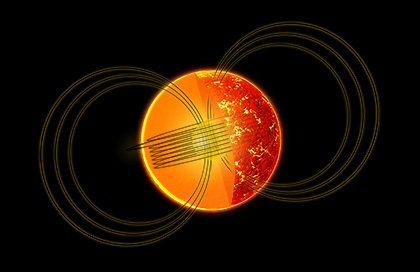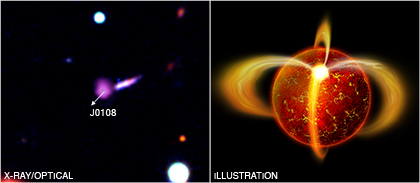Neutron Stars/X-ray Binaries
Look Back Time -- Remembering Franco
The finite speed of light means that we must always be out of date, no matter how hard we strive to keep up with the times. The term look-back time refers to the time in the past when the light we now observe from a distant object was emitted. For example, deep Chandra observations have detected X-rays that have been travelling through intergalactic space for billions of years since they were emitted by jets of gas that were likely produced by rotating supermassive black holes. With these data, astronomers use Chandra and other telescopes as one-way time machines that enable them to see objects as they were in the past.
A Pulsar and its Mysterious Tail
A spinning neutron star is tied to a mysterious tail - or so it seems. Astronomers using NASA's Chandra X-ray Observatory have found that this pulsar, known as PSR J0357+3205 (or PSR J0357 for short), apparently has a long, X-ray bright tail streaming away from it.
This composite image shows Chandra data in blue and Digitized Sky Survey optical data in yellow. The two bright sources lying near the lower left end of the tail are both thought to be unrelated background objects located outside our galaxy.
What Lies Beneath? Magnetar Enigma Deepens
Observations with NASA's Chandra, Swift, and Rossi X-ray observatories, Fermi Gamma-ray Space Telescope, and ESA's XMM-Newton have revealed that a slowly rotating neutron star with a comparatively very weak surface magnetic field is giving off bursts of X-rays and gamma rays. This discovery may indicate the presence of an internal magnetic field much more intense than the surface magnetic field, with implications for how the most powerful magnets in the cosmos evolve.
Geriatric Pulsar Still Kicking
The composite image on the left shows an image from NASA's Chandra X-ray Observatory in purple and an optical image from the European Southern Observatory's Very Large Telescope (VLT) in red, blue and white. The Chandra source in the center of the image is the ancient pulsar PSR J0108-1431 (J0108 for short), located only 770 light years from us. The elongated object immediately to its upper right is a background galaxy that is unrelated to the pulsar. Since J0108 is located a long way from the plane of our galaxy, many distant galaxies are visible in the larger-scale optical image.
Science Behind the Scenes: RX J0720
The press and image releases from the Chandra X-ray Center cover only a small fraction of the science results produced by Chandra each year. Some results are clearly not good candidates for publicity because they're obviously incremental - I've written papers like that myself. Or they can be highly esoteric, addressing questions that only the authors knew enough about the subject to ask! It also doesn't help if the results are completely unsurprising or if there isn't a decent image.
Neutron Star Discovered Where a Black Hole Was Expected
Dr. Muno uses Chandra to study the black holes and neutron stars that are left behind when the largest stars exhaust their fuel and collapse. Read the blog




